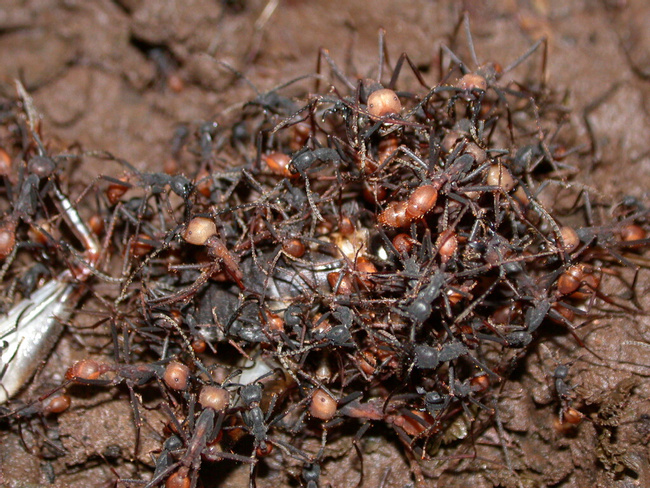
More about Army Ant
Habitat
The swarms of this species can be found blanketing forest floors in lowland, premontane, and montane forests.
Range
This fairly common species of army ant is found throughout the Neotropics.
Physical Description
There are approximately 150 species of army ants, but this species is the most famous and has the widest range. Eciton burchelli is black. The queen is drastically different from the other nest members. Males have wings and are born expressly to leave the colony, mate with a queen, and die. The size and proportions of a worker ant are determined by diet when it is young. The soldiers have larger bodies, exaggeratedly gigantic heads, and big hooked mandibles. The smallest workers are 1/5 the size of a soldier and have no mandibles.
Biology and Natural History
These army ants organize breathtaking raids as they cooperatively search for food. Their colonies are composed of the queen, a few males, millions of workers, and young offspring. Instead of building a permanent nest in the ground or in the trees, these army ants make a nest out of their bodies. To form this bivouac, some of the workers hold onto each other to form the walls and chambers of the nest holding the queen, the new eggs, and the developing brood. The colony moves between two stages of behavior, stationary and migratory, which depend on the queen’s reproductive phase. If she is laying new eggs, the colony will find a more protective corner of the forest to keep her safe for about 20 days. If she is done laying eggs for a while, the ants will migrate and set up a new bivouac every night.
Each morning the raid begins when workers leave the bivouac in a column that fans out from the nest. As they move in different directions the ants communicate through pheromones and chemical signals. The columns move continuously over the terrain—trees, rocks, porches, or whatever is in their path become blanketed in ants. Army ants define “food” as anything small enough for them to take down. This fan-shaped force moving among the trees can last much of the day and reach more than 50 m away from the bivouac.
As the raid swarms through the forest, there is a chain reaction on the forest floor. Small arthropods rush away as the army ants race after them, and if crickets or katydids evade the ants, antbirds will snatch them up. These species of birds follow the army ant raids and watch for large, fast insects as well as lizards or frogs to burst out of the leaf litter; these birds never eat the army ants. The antbirds leave droppings as they follow the swarms, and certain butterflies, like the glasswings, follow the antbirds to feed on their droppings.
While it can be imposing to come across these ants in the wild, their hunting parties can be easy to step around. Occasionally a raid column is several meters wide across, and it is important to use care. It can be particularly interesting when the ants begin to raid across a house or building porch. Given a little time, they won’t stay in human dwelling places, but will carry off any bugs they find under the bed. These ants are by no means hunting humans but they should be left alone, as they do bite hard in self-defense. Their mandibles are so strong, that some native cultures have used the ants to suture wounds. After coercing the ant to bite either side of a cut, they would twist off the body and leave the head with the ant’s jaws closed around the injury. Using multiple ants would have a similar effect to stitching the wound.
Diet
The army raid will seek out and capture mostly spiders and insects, such as caterpillars, millipedes, cockroaches, or katydids. The army will attack other ant colonies and wasp nests. Vertebrates with any speed are usually able to escape these arthropod predators, but when given the opportunity the ants will pursue frogs, lizards and snakes.
Height/Weight
The workers of these colonies are the smallest, with a body length of approximately 3 mm. The heartier soldiers can be 9 to 14 mm long. The queen is enormous at several centimeters in length.
Taxonomy
Subfamily: Ecitoninae
Order: Formicidae
Sources
Hogue, Charles L. Latin American Insects and Entomology. University of California Press: Berkely and Los Angeles, 1993.
Kricher, John. A Neotropical Companion: an introduction to the animals, plants, and ecosystems of the New World tropics. Princeton University Press: Princeton, NJ, 1997.
Rettenmeyer, C. W. in Janzen, Daniel H. Costa Rican Natural History. Chicago: University of Chicago Press, 1983.
-Amy Strieter, Wildlife Writer
Similar Profiles
It's more than just having a good time or visiting beautiful places (although that's absolutely a part of it!), it's about being part of a unique experience that stays with you.



